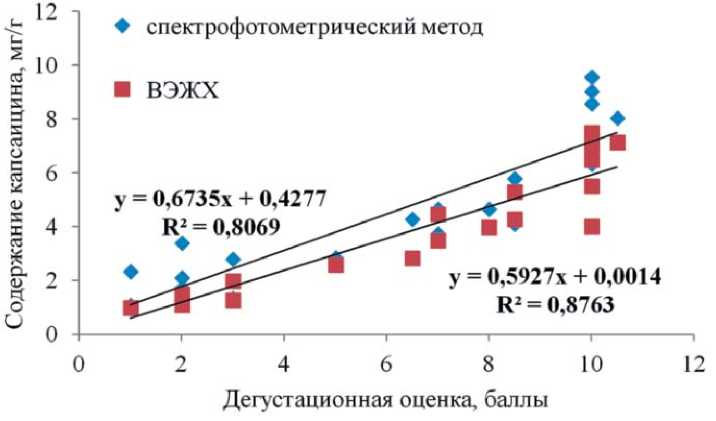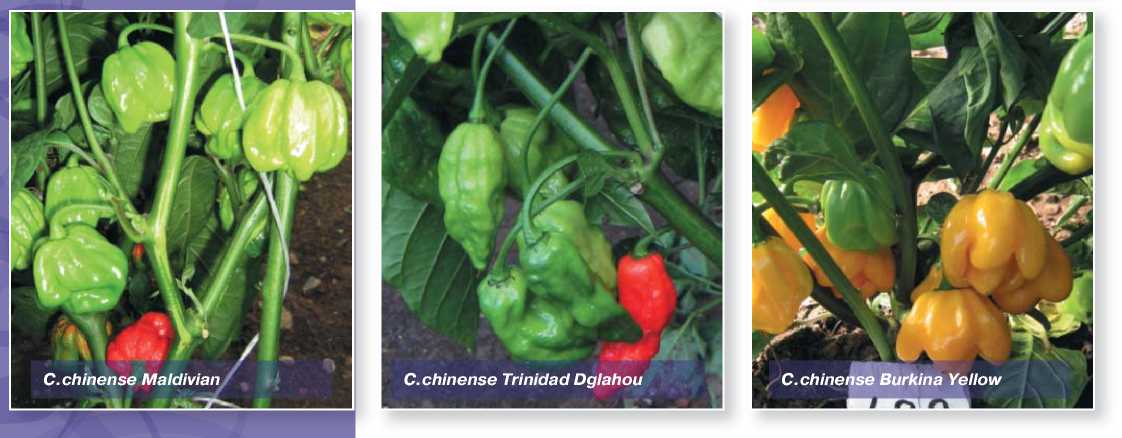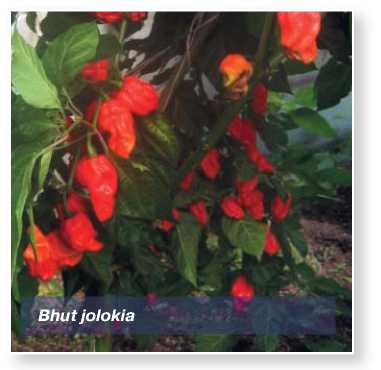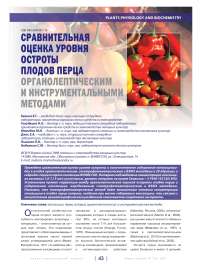Сравнительная оценка остроты перца органолептическим и инструментальными методами
Автор: Кекина Е.Г., Голубкина Н.А., Мамедов М.И., Джос Е.А., Пышная О.Н., Надежкин С.М.
Журнал: Овощи России @vegetables
Рубрика: Физиология и биохимия растений
Статья в выпуске: 1 (26), 2015 года.
Бесплатный доступ
Проведена сравнительная оценка уровня остроты и количественное содержание капсаициноидов в плодах органолептическим, спектрофотометрическим и ВЭЖХ методами в 20 образцах и гибридах перца острого коллекции ВНИИССОК. Интервал наблюдаемых концентраций капсаицина составил 1,0-7,15 мг/г сухой массы, уровень остроты по шкале Сковилла - (17440-153120) SHU. Установлена прямая корреляция между органолептической оценкой остроты плодов перца и содержанием капсаицина, определенным спектрофотометрическим и ВЭЖХ методами. Показано, что спектрофотометрический метод дает завышенные значения концентрации капсаицина в плодах перца острого, особенно при малом содержании капсаицина, что связано с отсутствием хроматографического разделения компонентов спиртового экстракта.
Капсаицин, перец острый, органолептический и инструментальные методы
Короткий адрес: https://sciup.org/14025140
IDR: 14025140 | УДК: 635.649:581.19
Текст научной статьи Сравнительная оценка остроты перца органолептическим и инструментальными методами
Отличительной особенностью перца острого является способность синтезировать алкалоиды – капсаицины, – ответственные за острый вкус плодов. Эти соединения представляют собой ванилиламиды с оcтатками жирных кислот разной длины углеводородной цепи (Reyes-Escogido et al., 2011). К наиболее распространенным капсаицинам относят капсаицин и дигидрокапсаицин, содержание которых в плодах достигает 90%, из которых капсаицин составляет около 71% для большинства острых сортов (Kosuge, Furuta, 1970). Повышенный интерес к селекции острых сортов перца определяется высокой биологической активностью капсаицинов, проявляющейся в антиоксидантном действии
(Materska, Perucka, 2005), антиканцерогенной защите (Macho et al., 2003), улучшении энергетического обмена и подавлении процесса аккумулирования жира (Watanabe et al., 1987), а также в противовоспалительном (Backonja et al., 2010) и противоязвенном действии (Mozsil et al., 2005).
Острота перца оценивается по шкале Сковилла и имеет 5 уровней:
1) не острые (0-700 SHU), 2) слабо
Капсаицин относятся к группе при-
Материалы и методы острые (700-3000), 3) умеренно острые (3000-25000), 4) острые (2500070000) и 5) очень острые (более
80000 SHU) (Weiss, 2002). Следует, однако, отметить, что в настоящее родных антиоксидантов, способных улавливать свободные радикалы, присоединяться к белкам и участво- вать в сигнальной системе организма человека (Padayatty et al., 2003).
Исследован 21 сорт и гибрид (Bhut jolokia, Sukanya, Rocoto, Black, Habolokia, Рябинушка, Декоративный,
Меч, Идея, Конопушка, Burkina Yellow, Scorpion Morouga Trinidad, Caimarca, время органолептический тест ост-
Известно, что различные виды и
Pimenta Barra Do Ribiero, Trinidad роты перца все чаще заменяют на сорта перца сильно различаются по
Scorpion Chocolate, Trinidad Dglaou, хроматографические методы оценки, которые обеспечивают большее удобство и точность (Nwokem et al., 2010). Концентрация соединений группы капсаицина обычно состав- ляет от 0,1 до 2,5 мг/г (Parrish, 1996). Для сортов перца, относящихся к разным видам: Capsicum annuum, C.
frutescens, C. chinense установлено содержание капсаицина от 0,22 до 20 мг/г сухой массы (Thomas et al., морфологическим характеристикам и биохимическому составу, определяемому генотипом, а также характерными особенностями окружающей среды (Wahyuni et al., 2011;
Hornero-Mendez et al., 2002; Topuz, Ozdemir, 2007).
Целью настоящей работы была оценка уровня остроты и количественного содержания капсаицинои-дов у 20-и сортообразцов и гибридов
Maldivian, Beni Highlands, Peruviana, Lanterna) перца острого коллекции ВНИИССОК, относящихся к видам C. annuum, C. baccatum, C. pubescens, C.chinense , и межвидовому гибриду
C. chinense x C. frutescens – Bhut jolo-kia . Растения выращивали в условиях пленочной теплицы с мая по сентябрь
2014 года. С каждого образца отбирали по 10-50 спелых плодов (в зависимости от размера плода) с двух
1998). По данным Bajaj (1980), содер- перца острого, выращенного в усло- наиболее типичных растений. Плоды жание капсаицина в плодах перца острого варьирует от 7,6 до 497,0
виях защищенного грунта
Московской области с использовани- высушивали до постоянной массы. 5 г плодов помещали в 100 мл колбу, мг/100 г спелых плодов и 278-404,5
ем органолептического и инструмен- содержащую 5 мл этанола, плотно мг/100 г зеленых.
тальных методов анализа.
закрывали и помещали в водяную
баню при 80°С на 4 часа, периодически перемешивая. Затем образцы охлаждали, супернатант фильтровали и хранили при 5°С до начала анализа.
Максимум поглощения капсаицина и дигидрокапсаицина соответствует 281 нм, что позволяет определять эти капсаициноиды одновременно и спектрофотометрически (American Spice Trade Association, 1992).
Статистическую обработку результатов осуществляли с использованием критерия Стьюдента.

PLANTS PHYSIOLOGY AND BIOCHEMISTRY
Результаты и обсуждение
В таблице представлены результаты уровня остроты образцов перца, установленные органолепти-
Наименьшее количество капсаицина, установленное для образца C. chinense из Перу, определяется, по-видимому, тем, что плоды были коротковолновой области спектра (около 280 нм) наблюдается максимум поглощения не только капсаицина, дигидрокапсаицина и нордигидрокапсаицина, но и ческим, спектрофотометрическим собраны в фазу технической спело- некоторых других природных соедине-
(шкала Сковилла) и ВЭЖХ методами. Средние концентрации капсаицина в исследуемых образцах находились в интервале концентраций 1,09-8,05 мг/г сухой массы. Наиболее острые сорта (C. chinense Trinidad Scorpion, Trinidad Dglahou, Maldivian и Bhut jolokia) соответствовали 137000153000 SHU шкалы Сковилла, в то время как cорта c показателями 17400-23300 SHU были отнесены к группе умеренно острых.
сти, когда содержание капсаицина еще не достигает максимума (Bajaj,
1980). Полученные результаты соответствуют известным литературным данным по содержанию капсаицина в плодах различных видов Capsicum L. (Collins et al., 1995; Tilahun et al., 2013).
Исследованиями установлено (рис.1.), что содержание капсаицина, определенное спектрофотометрическим методом выше, чем по ВЭЖХ. Действительно, в ний. Поскольку спектрофотометрический метод не предусматривает выделение чистого капсаицина, то он дает завышенные результаты. Тем не менее, следует отметить, что в целях быстрой оценки сор-тообразцов и отбора индивидуальных растений с высоким содержанием капсаицина спектрофотометрический метод более удобен благодаря простоте и малому времени анализа.
Следует отметить, что органолептические исследования позволяют не только
|
Вид |
Сорт |
Органолептическая оценка остроты в баллах |
Происхождение |
Содержание капсаицина, мг/г сухой массы Спектрофотометри ВЭЖХ чески |
Шкала Сковилла |
|
|
C. chinense x C. frutescens |
Bhut jolokia * |
10 и более |
Индия |
8,05 |
7,15 |
128800 |
|
C. pubescens |
Sukanya |
7 |
- |
4,67 |
4,88 |
74720 |
|
C. pubescens |
Rocoto |
6-7 |
Эквадор |
4,3 |
2,84 |
68800 |
|
C. annuum x C. frutescens |
Рябинушка |
5-6 |
ВНИИССОК |
2,86 |
2,59 |
45760 |
|
C. annuum |
Gish |
1 |
США |
2,35 |
1,0 |
21600 |
|
C. annuum |
Black |
2 |
США |
3,41 |
1,1 |
22560 |
|
C. annuum |
Конопушка |
8-9 |
ВНИИССОК |
4,12 |
4,3 |
65920 |
|
C. annuum |
Меч |
1-2 |
ВНИИССОК |
2,12 |
1,5 |
28800 |
|
C. annuum |
Идея |
2-3 |
ВНИИССОК |
2,8 |
2,0 |
44800 |
|
C. annuum |
Декоративный |
7 |
Италия |
3,74 |
3,5 |
59840 |
|
C. chinense |
Habolokia |
8-9 |
Бразилия |
5,79 |
5,3 |
92640 |
|
C. chinense |
Burkina Yellow |
10 |
Африка |
6,34 |
4,03 |
101440 |
|
C. chinense |
Scorpion Morouga Ttinidad |
10 |
Тринидад |
6,57 |
5,52 |
105120 |
|
C. chinense |
Caimarca |
1 |
Перу |
1,09 |
1 |
17440 |
|
C. chinense |
Lanterna |
2 |
Италия |
1,38 |
1,1 |
22080 |
|
C. baccatum |
Pimenta Barra Do Ribiero |
2 |
Бразилия |
1,72 |
1,5 |
27520 |
|
C. chinense |
Trinidad Scorpion Chocolate |
9-10 |
Тринидад |
9,04 |
7,1 |
144640 |
|
C. chinense |
Trinidad Dglahou |
9-10 |
Тринидад |
9,57 |
7,5 |
153120 |
|
C. chinense |
Maldivian |
10 |
Мальдивы |
8,57 |
6,5 |
137120 |
|
C. chinense |
Beni Highlands |
3 |
- |
1,36 |
1,29 |
23360 |
|
Неизвестный |
Peruviana |
8 |
- |
4,67 |
4,0 |
74720 |
*естественный гибрид (C.chinense x C. frutescens)
COMPARATIVE EVALUATION OF HOT PEPPER PUNGENCY BY ORGANOLETIC AND INSTRUMENTAL METHODS
Kekina H.G., Golubkina N.A., Mamedov M.I., Djos H.A., Pishnaya O.N., Nadezhkin S.M.
Federal State Budgetary Scientific Institution All-Russian Scientific Research Institute of Vegetable Breeding and Seed Production 143080, Russia, Moscow region, Odintsovo district, VNIISSOK, Selectsionnaya st., 14

2 я' г
= я S я я к
<и X X я а
2 4 6 8 10 12
Дегустационная оценка, баллы
♦ спектрофотометрический метод вэжх у = 0,5927x4 0,0014 R2 = 0,8763
у = 0,6735х + 0,4277 R2 = 0,8069
Рис.1. Взаимосвязь содержания капсаицина и органолептической (балльной) оценки остроты плодов перца.
отличать интенсивность остроты, но и воспринимать каждый капсаициноид по-разному. Органолептическими оценками Мамедова М.И. обнаружено, что капсаи-циноиды содержащиеся в плодах, по-разному вызывает раздражение и жжение. У одних сортов это чувствуется передней частью рта и неба, у других жжение ощущается немедленно после проглатывания и быстро сходит на нет, у третьих жгучесть ощущается в середине рта и неба, а у некоторых образцов, как в горле, так и задней части языка. Различные комбинации капсаициноидов вызывают разное ощущение теплоты, и это у каждого сорта индивидуально. Кроме того, плоды перца острого, кроме жгучести, значительно различаются как по вкусу, так и по аромату. Кисло-сладкий, сладко-кислый, горький, шоколадный, миндальный, апельсиновой кожуры и другие, часто встречающиеся вкусовые ощущения плодов перца острого – чилли.
Высокое содержание капсаицина в плодах перца острого открывает возможности не только дальнейшей селекции, но и использования экстрактов плодов для эффективной борьбы с вредителями (Gudeva et al, 2013).

C.chinense Trinidad Dglahou

Bhut jolokia
■ЯМГ^ЧМ W
PLANTS PHYSIOLOGY AND BIOCHEMISTRY
Список литературы Сравнительная оценка остроты перца органолептическим и инструментальными методами
- Голубкина Н.А., Джос Е.А., Пышная О.Н., Мамедов М.И. Надежкин С.М. Некоторые биохимические особенности плодов перца острого, выращенного в Московской области//Доклады РАСХН, 2013. -№6.-С.24-27.
- American Space Trade Association. Рaprika oleoresin FNP. -1992.-Vol.52.
- Antonious G.F., Kochhar T.S., Jarret R.L., Snyder J.C. Antioxidants in hot pepper: variation among accessions//Journal of Environmental Science and Health, 2006.-Vol.41.-№ 7.-P.1237-1243.
- Backonja M.M., Malan T.P., Vanhove G.F., Tobias J.K. NGX-4010, a high-concentration capsaicin patch, for the treatment of postherpetic neuralgia: a randomized, double-blind, controlled study with an open-label extension//Pain Medicine, 2010.-Vol.11.-P.600-608.
- Bajaj K.L. Colorimetric determination of capsaicin in Capsicum fruits//Journal of Association of Official Analytical Chemists, 1980.-Vol.42.-№6.-P.1314-1316.
- Bernal M.A., Ros Barcelo A. 5,5’-dicapsaicin, 4’-0-5-dicapsaicin ether and dehydrogenation polymers with high molecular weights are the main products of the oxidation of capsaicin by proxidase from hot pepper//Journal of Agricultural and Food Chemistry, 1996.-Vol.43.-P.352-355.
- Collins M.D., Mayer-Wasmund L., Bosland P.W. Improved method for quantifying capsaicinoids in Capsicum using high performance liquid chromatography//Horticulture Science, 1995.-Vol.30. -P.137-139.
- Davis C.B., Markey C.E., Busch M.A., Busch K.W. Determination of capsaicinoids in habanero peppers by chemometric analysis of UV spectral data//Journal of Agricultural and Food Chemistry, 2007.-Vol.55.-P.5925-5933.
- Hernandez-Ortega M., Ortiz-Moreno A., Hernandez-Navarro M.D., Chamorro-Cevallos G., Dorantes-Alvarez L., Necoechea-Mondragon H. Antioxidant, antinociceptive, and anti-inflammatory effects of carotenoids extracted from dried pepper (Capsicum annuum L.)//Journal of Biomedicine and Biotechnology, 2012.-Vol. 2012.-Article ID 524019, 10 pages, 2012 DOI: 10.1155/2012/524019
- Gudeva L.K., Mitrev S., Maksimova V., Skasov D. Content of capsaicin extracted from hot pepper (Capsicum annuum ssp microcarpum L.) and its use as an ecopesticide//Hemijska Industrija, 2013.-Vol.67.-№ 1. P.671-675.
- Hornero-Mendez D., Costa-Garcia J., Minguez-Mosquera M.I. Characterization of carotenoid high-producing Capsicum annuum cultivars selected for paprika production//Journal of Agricultural and Food Chemistry, 2002. -Vol.50.-P.5711-5716.
- Howard L. R., Wildman R. E. C. Antioxidant vitamin and phytochemical content of fresh and processed pepper fruit (Capsicum annuum). In R. E. C. Wildman (Ed.), Handbook of nutraceuticals and functional foods. -2007.-2nd ed. -Р. 165-191. Boca Raton: CRC Press.
- Kosuge S., Furuta M. Studies of the pungent principle of Capsicum/Part XIV: Chemical constitution of the pungent principle//Agricultural and Biological Chemistry, 1970.-Vol.34.-P.248-256.
- Macho A., Lucena C., Sancjo R., Daddario N., Minassi A., Munoz E., Appendino G. Nonpungent capsaicinoids from sweet pepper synthesis and evaluation of the chemopreventive and anticancer potential//European Journal of Nutrition, 2003.-Vol.42.-P.2-9.
- Materska M., Perucka I. Antioxidant activity of the main phenolic compounds isolates from hot pepper fruit (Capsicum annuum L)//Journal of Agricultural and Food Chemistry, 2005. -Vol.53.-P.1750-1756.
- Mozsil G., Szolcsanyi J., Racz I. Gastroprotection induced by capsaicin in healthy human subjects//World Journal of Gastroenterology, 2005.-Vol.11.-P.5180-84.
- Nwokem C.O., Agbaji E.B., Kagbu J.A., Ekanem E.J. Determination of capsaicin content and pungency level of five different peppers grown in Nigeria//NY Science Journal, 2010.-Vol.3.-P.17-21.
- Padayatty S.J., Katz A., Wang Y., Eck P., Kwon O., Lee J.H., Chen S., Corpe C., Dutta A., Levine M. Vitamin C as an antioxidant: evaluation of its role in disease prevention//The Journal of the American College of Nutrition, 2003.-Vol.22.-P.18-35.
- Pandey J., Singh J., Verma A., Singh A.K., Rai M., Pandey A.K., Kumar S. Variability in quality components of RILs in chilli (Capsicum annuum L.)//Proceedings of IV Balkan Symposium on vegetables and Potatoes-ISHS Acta Horticulturae.-2011.-P.830.
- Parrish M. Liquid chromatographic method of determining capsaicinoids in capsicums and their extractives: collaborative study//Journal of Association of Official Analytical Chemists, 1996.-Vol.79.-P.738-745.
- Reyes-Escogido M., deLourdes, Gonzalez-Mondragon E.G., Vazquez-Tzompantzi E. Chemical and pharmacological aspects of capsai-cin//Molecules, 2011.-Vol.16.-P.1253-1270.
- Saha., Supradip Hedau N. K., Kumar S., Mahajan V., Gupta H. S. Variability in hot pepper for phytochemicals offers promising tools in plant-breeding programmes//Acta Agriculture Scandinavica Section B-Soil & Plant Science, 2010. -Vol. 60. -Issue 3. -P. 227-234.
- Sanatombi K., Sharma G.J. Capsaicin content and pungency of different Capsicum spp. cultivars//Notulae Botanicae Horti Agrobotanici Cluj-Napoca, 2008.-Vol.36.-P.89-90.
- Thapa B., Skalko-Basnet N., Takano A., Masuda K., Basnet P. High-performance liquid chromatography analysis of capsaicin content in 16 Capsicum fruits from Nepal//Journal of Medicinal Food, 2009.-Vol.12.-P.908-913.
- Thomas B.V., Schreiber A.A., Weisskopf C.P. Simple method for quantitation of capsaicinoids in peppers using capillary gas chromatograp-hy//Journal of Agricultural and Food Chemistry, 1998.-Vol.46.-P.2655-2663.
- Tilahun S., Paramaguru P., Rajamani K. Capsicum and ascorbic acid variability in chilli and paprika cultivars as revealed by HPLC analysis//Journal of Plant Breeding and Genetics, 2013.-Vol.1.-№2.-P.85-89.
- Topuz A., Ozdemir F. Assessment of carotenoids, capsaicinoids and ascorbic acid composition of some selected pepper cultivars (Capsicum annuum) grown in Turkey//Journal of Food Composition and Analysis, 2007.-Vol. 20.-P.596-602.
- Wahyuni Y., Ballester A. R., Sudarmonowati E., Bino R. J., Bovy A. G. Metabolite biodiversity in pepper (Capsicum)fruits of thirty-two diverse accessions: Variation in health-related compounds and implications for breeding//Phytochemistry, 2011.-Vol.72.-P.1358-1370
- Watanabe T., Kawada T., Yamamoto M., Iwai K. Capsaicin, a pungent principle of hot red pepper. Evokes catecholamine secretion from the adrenal medulla of anesthetized rats//Biochemical and Biophysical Research Communication, 1987.-Vol.142.-P.259-264
- Weiss E.A. Spice crops//CABI Publishing International: NY, USA, 2002.-P.411


